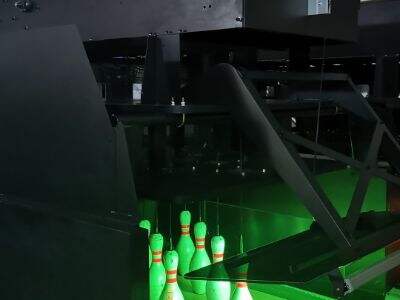Xushida a participat la IAAPA Asian Attractions Expo de la Shanghai, China. Xushida este o companie de distracții cu mulți operatori amuzanți pentru public. Grădina zoologică era foarte entuziasmată să le arate vizitatorilor noile atracții de la expoziție și i-a impresionat pe aceștia cu atracțiile lor cu tehnologie avansată.
Xushida prezintă noi atracții la IAAPA Asian Attractions Expo de la Shanghai.
Xushida a avut un pavilion colorat la IAAPA Asian Attractions Expo de la Shanghai, unde a prezentat noile lor amuzamente. Aveau o roată uriașă care se ridica mai sus decât o clădire de școală și se rotea încet, oferind participanților o priveliște aeriană asupra expoziției. Lângă roata uriașă se afla un montagne russe cu curbe și bucle care făceau oamenii să țipe de plăcere.
Xushida fură atenția publicului la IAAPA Asian Attractions Expo de la Shanghai.
Exponatele Xushida i-au uimit pe vizitatorii târgului. Ei au stat la coadă pentru a urca în uriașa roată de carusel, iar când s-au înălțat prin buclele montagnei ruse au strigat entuziasmați. Mai mulți ingineri și designeri ai companiei Xushida erau prezenți pentru a răspunde la întrebări și a discuta despre modul în care construirea unor astfel de atracții spectaculoase seamănă foarte mult cu realizarea unui film excelent.
Xushida lansează o nouă atracție. Xushida prezintă o nouă atracție care își face publicitate lansării la IAAPA Asian Attractions Expo din Shanghai.
Unul dintre momentele importante ale târgului a fost anunțul privind cea mai recentă atracție Xushida, Sky Drop. Atracția avea forma unei turn care ridica participanții spre ceruri, pentru ca apoi să coboare cu viteză amețitoare. Observatorii prezenți la târg au oftat uimiți și au chicotit când au văzut participanții strigând și râzând pe parcursul acestei aventuri nebunești.
Xushida strălucește ca lider al industriei la IAAPA Asian Attractions Expo din Shanghai.
Xushida a avut grijă să demonstreze că sunt lideri în industria parcurilor de distracții. Au explicat cum au integrat cele mai avansate tehnologii și caracteristici de siguranță pentru a crea atracții distractive pentru toți, dar în același timp sigure. Sunt aceste valori de calitate și inovație care îi fac pe Xushida să se diferențieze de ceilalți la expoziție.
Xushida își invită cu toții care doresc să viziteze fabrica la IAAPA Asian Attractions Expo din Shanghai.
Pe durata expoziției, Xushida a comunicat cu lucrători din industrie din întreaga lume. Au discutat despre cele mai recente dezvoltări din lumea parcurilor de distracții și au schimbat idei pentru noi atracții și activități. Compania a petrecut, de asemenea, timp la eveniment reușind contacte și formând relații cu alte firme, astfel încât să rămână în fața celorlalți din industrie.
În general Xushida Jocul de biliard cu coardă a avut un show minunat aici, la IAAPA Asian Attractions Expo din Shanghai. Au prezentat cele mai noi succese, au impresionat vizitatorii cu atracții inovatoare, au lansat cu mare succes Sky Drop, au subliniat leadershipul lor în industrie și au dezvoltat relații profesionale cu colegi din domeniu. Dedicarea lui Xushida de a oferi atracții emoționante, dar în același timp sigure, de la început până la sfârșitul târgului, i-a uimit pe toți cei care au vizitat standul companiei. Copiii de toate vârstele vor avea ocazia să meargă la parc în acest an și să se bucure pe deplin de plăcerea și distracția aduse de Xushida.
Cuprins
- Xushida prezintă noi atracții la IAAPA Asian Attractions Expo de la Shanghai.
- Xushida fură atenția publicului la IAAPA Asian Attractions Expo de la Shanghai.
- Xushida lansează o nouă atracție. Xushida prezintă o nouă atracție care își face publicitate lansării la IAAPA Asian Attractions Expo din Shanghai.
- Xushida strălucește ca lider al industriei la IAAPA Asian Attractions Expo din Shanghai.
 EN
EN
 AR
AR
 BG
BG
 HR
HR
 CS
CS
 DA
DA
 NL
NL
 FI
FI
 FR
FR
 DE
DE
 EL
EL
 IT
IT
 JA
JA
 KO
KO
 NO
NO
 PL
PL
 PT
PT
 RO
RO
 RU
RU
 ES
ES
 SV
SV
 IW
IW
 ID
ID
 SR
SR
 UK
UK
 VI
VI
 HU
HU
 TH
TH
 TR
TR
 FA
FA
 MS
MS
 SW
SW
 UR
UR
 LA
LA
 PA
PA
 ZU
ZU
 TG
TG
 UZ
UZ
 PS
PS

/images/share.png)


